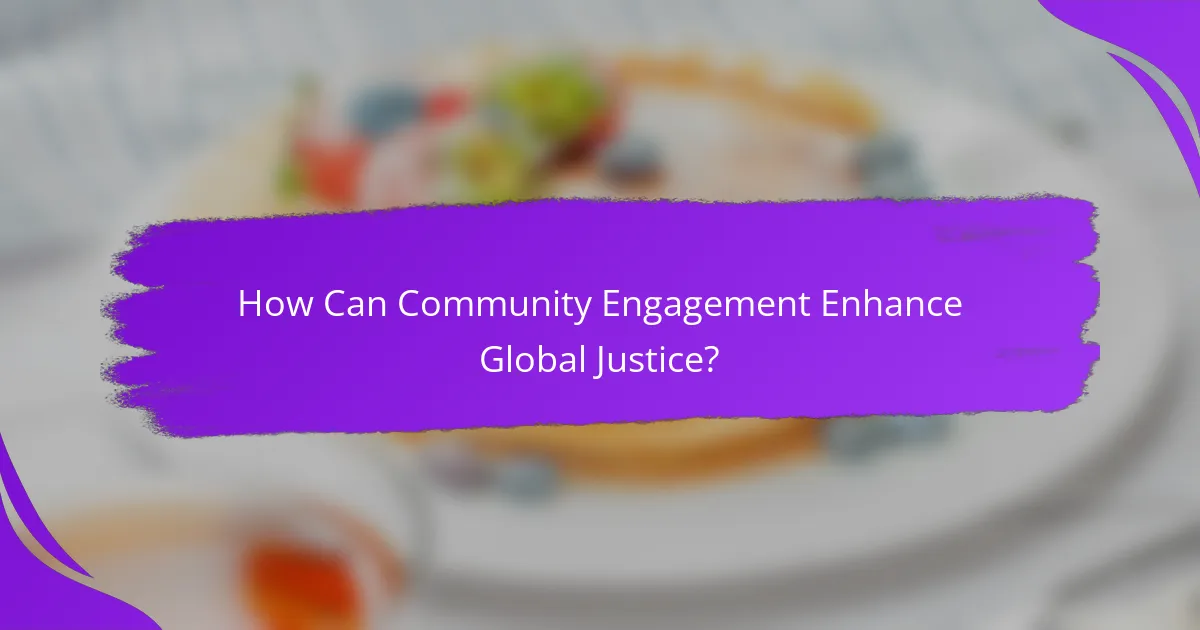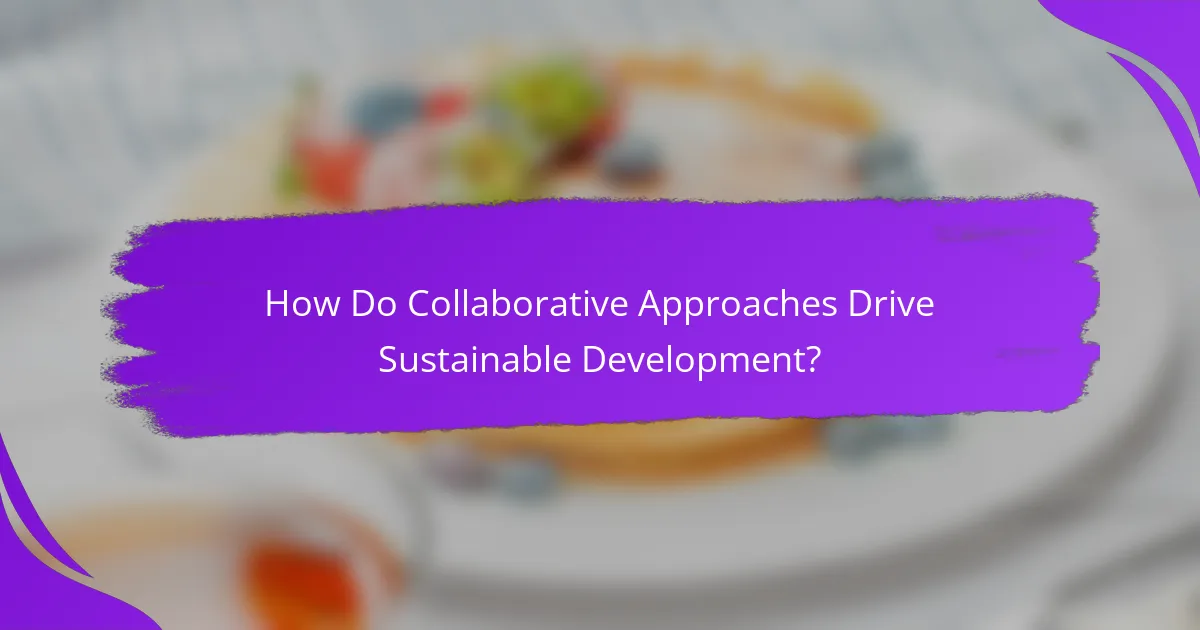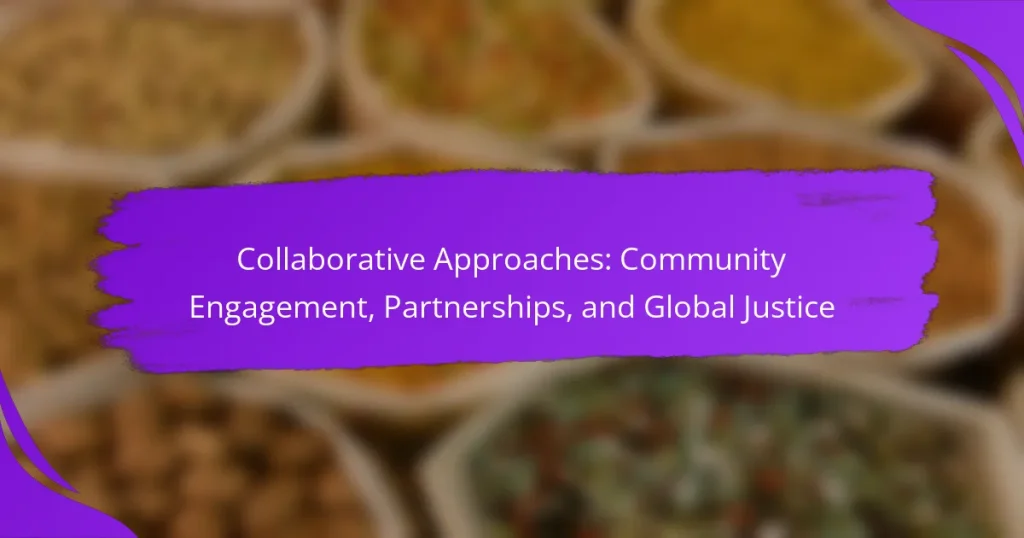Collaborative approaches to community engagement are essential for promoting global justice, as they empower individuals and foster inclusive decision-making. By leveraging the strengths of diverse stakeholders, these partnerships enhance resource sharing and knowledge exchange, enabling communities to tackle social, economic, and environmental challenges more effectively. Ultimately, such collaboration drives sustainable development and promotes equity on a global scale.

How Can Community Engagement Enhance Global Justice?
Community engagement plays a crucial role in enhancing global justice by fostering collaboration, raising awareness, and empowering individuals. By involving diverse groups in decision-making processes, communities can address social issues more effectively and create equitable solutions.
Increased awareness of social issues
Community engagement raises awareness of social issues by educating individuals about local and global injustices. This heightened awareness can lead to increased advocacy and support for initiatives aimed at addressing these challenges.
For example, community workshops and public forums can inform residents about issues such as poverty, discrimination, and environmental degradation. Engaging local media can further amplify these messages, reaching broader audiences.
Empowerment of marginalized voices
Engaging communities empowers marginalized voices by providing platforms for expression and participation. This empowerment is essential for ensuring that the needs and perspectives of underrepresented groups are acknowledged in decision-making processes.
Strategies such as participatory budgeting or community-led initiatives can help marginalized populations influence policies that directly affect their lives. This approach not only fosters inclusivity but also builds trust within communities.
Strengthened local networks
Community engagement strengthens local networks by fostering connections among individuals, organizations, and institutions. These networks facilitate collaboration, resource sharing, and collective action, which are vital for addressing complex social issues.
Local partnerships can include non-profits, businesses, and government agencies working together on community projects. Such collaborations can enhance the effectiveness of initiatives aimed at promoting social justice.
Collaborative problem-solving
Collaborative problem-solving involves bringing together diverse stakeholders to address social issues collectively. This approach leverages the unique perspectives and expertise of various community members, leading to more innovative and effective solutions.
For instance, community-led task forces can tackle issues like food insecurity by combining resources and knowledge from local farmers, health professionals, and residents. This collaboration can result in sustainable solutions that benefit the entire community.
Improved policy advocacy
Community engagement enhances policy advocacy by equipping citizens with the knowledge and tools needed to influence decision-makers. Informed and organized communities can effectively advocate for policies that promote justice and equity.
Training sessions on advocacy techniques, such as lobbying or public speaking, can empower community members to engage with local government officials. Additionally, creating coalitions with other organizations can amplify their voices and increase their impact on policy changes.

What Are Effective Partnership Models for Global Justice?
Effective partnership models for global justice involve collaborative efforts that leverage the strengths of various stakeholders to address social, economic, and environmental challenges. These models can enhance resource sharing, knowledge exchange, and community impact, ultimately promoting equity and justice on a global scale.
Public-private partnerships
Public-private partnerships (PPPs) combine resources and expertise from both government entities and private sector organizations to achieve common goals. These partnerships can be particularly effective in infrastructure projects, healthcare, and education, where investment and innovation are crucial.
When forming PPPs, it is essential to establish clear objectives and ensure accountability. For instance, a local government might partner with a private firm to improve public transportation, sharing costs and responsibilities while enhancing service delivery.
NGO collaborations
Non-governmental organizations (NGOs) often collaborate with each other to amplify their impact on global justice issues. These collaborations can take various forms, such as joint campaigns, resource sharing, and coordinated advocacy efforts.
Successful NGO collaborations require alignment on mission and goals. For example, two NGOs focused on climate change might work together on a project to promote renewable energy solutions in underserved communities, pooling their expertise and networks to maximize outreach and effectiveness.
Community-based organizations
Community-based organizations (CBOs) play a vital role in grassroots movements for global justice by addressing local needs and empowering residents. These organizations often work closely with community members to identify issues and develop tailored solutions.
Engaging with CBOs can enhance the relevance and sustainability of initiatives. For instance, a CBO might lead a campaign to improve access to clean water, involving local residents in decision-making and implementation to ensure the project meets their specific needs.
International coalitions
International coalitions bring together diverse stakeholders, including governments, NGOs, and private entities, to tackle global justice issues on a larger scale. These coalitions can address systemic problems like poverty, inequality, and human rights violations through coordinated action and policy advocacy.
Forming effective international coalitions requires clear communication and shared objectives. An example is the Global Fund, which unites various partners to combat diseases like HIV/AIDS and malaria, pooling resources and expertise to achieve significant health outcomes across multiple countries.

How Do Collaborative Approaches Drive Sustainable Development?
Collaborative approaches drive sustainable development by fostering partnerships that leverage shared resources and expertise, enabling communities to address complex challenges collectively. These strategies enhance the effectiveness of initiatives aimed at achieving long-term social, economic, and environmental goals.
Shared resources and expertise
Sharing resources and expertise among organizations and communities can significantly amplify the impact of development efforts. By pooling financial resources, knowledge, and skills, partners can tackle larger projects that would be unfeasible individually. For instance, NGOs often collaborate with local governments to combine funding and local knowledge, leading to more effective program implementation.
When engaging in resource sharing, it is crucial to establish clear agreements on contributions and responsibilities. This helps prevent misunderstandings and ensures that all parties are aligned toward common objectives. Regular communication and feedback mechanisms can further enhance collaboration.
Collective impact initiatives
Collective impact initiatives are structured efforts where diverse stakeholders work together to address a specific social issue. These initiatives typically involve a common agenda, shared measurement systems, and continuous communication among participants. An example is the collaboration between various organizations to reduce homelessness in urban areas, where each partner contributes unique insights and resources.
Successful collective impact requires commitment from all stakeholders and a willingness to adapt strategies based on shared data. It is important to establish a backbone organization to facilitate coordination and ensure that all voices are heard. This structure helps maintain momentum and focus on the shared goals.
Cross-sectoral strategies
Cross-sectoral strategies involve collaboration between different sectors, such as government, business, and civil society, to achieve sustainable development. These partnerships can lead to innovative solutions by integrating diverse perspectives and expertise. For example, a partnership between a tech company and a local government can enhance digital access in underserved communities.
To implement effective cross-sectoral strategies, stakeholders should identify common interests and establish mutual benefits. Regular stakeholder meetings can help maintain alignment and foster trust. Additionally, being open to feedback and adapting approaches based on results can enhance the effectiveness of these collaborations.

What Criteria Should Be Considered for Successful Collaborations?
Successful collaborations hinge on several key criteria that ensure all parties work effectively towards shared objectives. These criteria include alignment of goals and values, clear communication channels, and mutual benefits paired with accountability.
Alignment of goals and values
For collaborations to thrive, all partners must have aligned goals and values. This alignment fosters a sense of unity and purpose, making it easier to navigate challenges together. Organizations should conduct initial assessments to identify overlapping missions and visions.
Establishing a shared framework can be beneficial. For example, if two nonprofits aim to improve community health, they should define specific outcomes they both prioritize, such as reducing obesity rates or increasing access to healthcare services.
Clear communication channels
Effective communication is crucial for any successful collaboration. Establishing clear channels ensures that all partners can share updates, feedback, and concerns promptly. Regular meetings, shared digital platforms, and open lines of communication help maintain transparency.
Using tools like project management software can streamline communication. For instance, platforms such as Slack or Trello allow teams to track progress and address issues in real-time, minimizing misunderstandings and fostering a collaborative spirit.
Mutual benefits and accountability
Collaborations should offer mutual benefits to all parties involved. This means that each partner should gain value from the relationship, whether through resources, knowledge, or enhanced reputation. Clearly defined roles and contributions can help ensure that everyone feels invested.
Accountability mechanisms are equally important. Establishing benchmarks and regular evaluations can help partners assess their contributions and the overall impact of the collaboration. For example, setting quarterly reviews can provide opportunities to celebrate successes and address any shortcomings collaboratively.

What Are the Challenges in Community Engagement?
Community engagement faces several challenges that can hinder effective collaboration. Key obstacles include resource limitations, cultural barriers, and a lack of trust among stakeholders.
Resource limitations
Resource limitations often restrict the ability of communities to engage effectively. This can include insufficient funding, lack of personnel, or inadequate facilities to host events and meetings.
To overcome these limitations, communities can seek partnerships with local organizations or government agencies that may provide financial or logistical support. Establishing a budget and prioritizing essential activities can also help maximize available resources.
Cultural barriers
Cultural barriers can significantly impact community engagement efforts. Differences in language, customs, and social norms may lead to misunderstandings or alienation of certain groups.
To address these barriers, it is crucial to involve community members in the planning process and ensure that communication is culturally sensitive. Providing materials in multiple languages and respecting local traditions can facilitate better engagement.
Lack of trust
A lack of trust among community members and organizations can impede collaboration. Historical grievances, perceived inequities, or past negative experiences can contribute to skepticism about engagement initiatives.
Building trust requires consistent communication, transparency, and follow-through on commitments. Engaging community leaders and influencers can also help bridge gaps and foster a more trusting environment.


